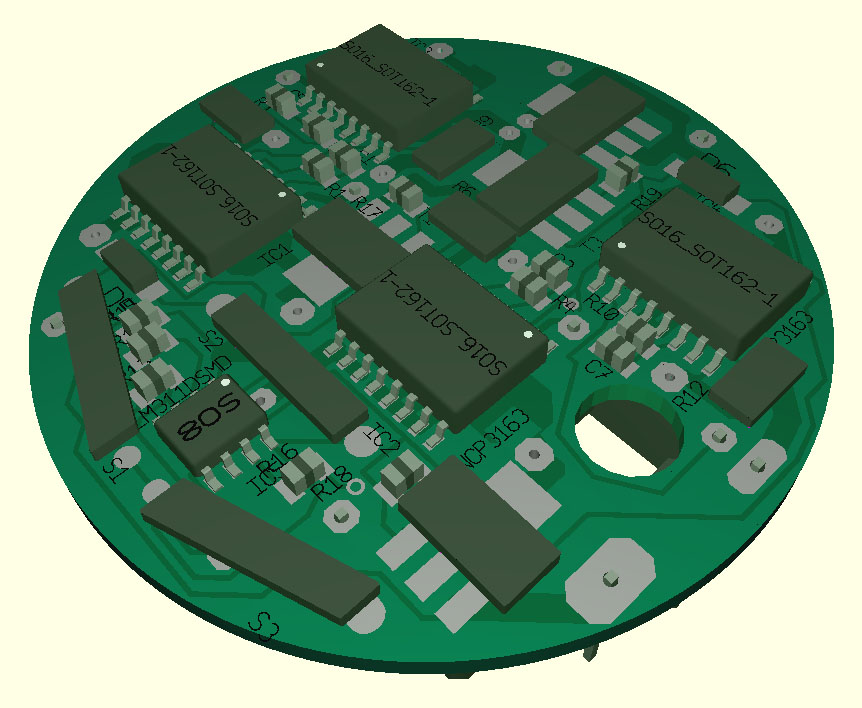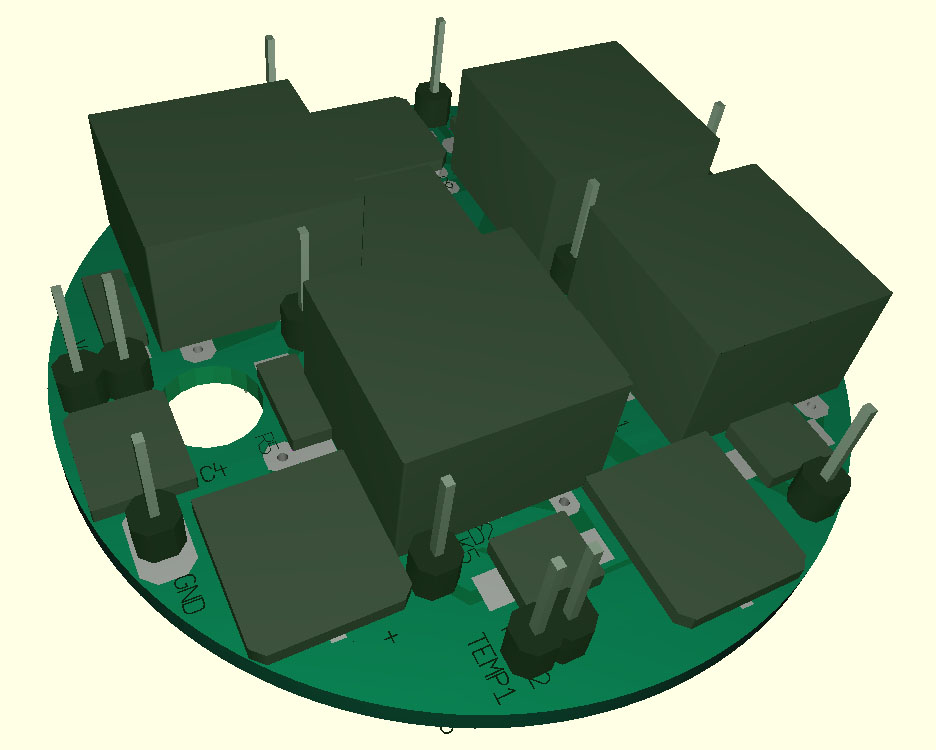The electronic
The electronic was the hardest part in the development of this lamp. On the one hand there is no ready-to-use standard electronic with all the necessary features on one PCB and on the other hand I don´t want to give up the extreme redunance and robustness of four LEDs with only one driver electronic. So I had to design a PCB that implements four striktly devided driver stages so when one or two are failing the rest can burn further on. I think when working with leds the electronic is the far bigger failing factor.
Another problem is the quite high driving voltage of the six chip OSTAR of around 20V. LEDs have no distict diving voltage - it can vary in a defined voltage range. So when driving LED you have to limit the current instead of the voltage. Nevertheless a standard 12V accu pack should do the job. Cause of this the input voltage of 12V have the be boosted to the desired 20V driving voltage with exact 700mA current through one emitter - regardless of the actual accu voltage. Every emitter should be driven by a single step-up driver with build in shortcut protection and it must not affect the other drivers in cause of failure. Besides that a automatic step down regulation of the driving current is implemented with draining accu pack. This regulation cut off the emitters piece for piece with falling accu voltage until it shuts down the lamp completly the prevent an accu damage.
Obviously it is impossible to fit all this functions on one small 50mm diameter board when not using the smalest component size and that are the SMD (surface mounted device) parts. Moreover every driving part of the PCB needs quite big condensators and coils that are essential for a step-up (boost) driver from 12V to 20V. The solution was to mount the smaller parts that needs cooling on the bottom and the bigger parts on the other side. The four drive ICs on the bottom needs direct contact with the housing for cooling.
This is a 3D view at the ready-to-use electronic just like it is build in my prototype. It was made with a PC based electronic CAD programm. You can clearly see the four big driving ICs and the coils on the other side.
The electronic has the following features :
- seperated step-up driver for every single emitter from 7-15V up to 18-25V with regulated current at 700mA
- Full and smooth brightness over nealy the whole voltage range of a 12V accu pack
- automatic reduction of the activated emitters down to two and at least one emitter with reaching the end of the accu capacity
- automatic shut down against deep dischange with very less mA standby current
- integrated SMD reedswitches for the 3 stage regulation
- MOSFET control of the whole electronic with a standby current of <10µA so that a shut down only with the magnet switch is possible. 10µA is far less than the normal selfdischange of a NiMH accupack.
- temperaturecontrol that goes into a fast on/off mode when reaching above 70°C to prevent the lamp from damage cause of overheating above the water but don´t shuts down the lamp completly so that a emergency light is still availible
- protection of each driver stage against shortcut, overvoltage und wrong polarity
- There can be up to 3 parts failing until the lamp shuts down completly!
When testing and designing the lamp a had two times when water came into the housing and everytime the lamp keeps up burning with at least one emitter..so it seems to work :-)
The actual design of the electronic has a height of 12mm so that there is enough room left for the emitter board and its wires. There is so much room that even a littler smaller form factor would be possible. The four driving ICs on the bottom needs some thermal compound when they are build into the housing cause there are up to 3A current going though this ICs. If not this would overheat the ICs and they have to shut down with their build in thermal protection. Because of this and the reasons mentioned above this lamp should be extremly robust against every typ of failure. You can hammer a nail underwater with this lamp and it would not fail.. try this never with your HID light. :-) Optimal is to mould the complete electronic into epoxy so that even a water invasion can not leed to a failure (leave only the top surface of the four driving ICs free for a good heat transfer!). Doing so you get a diving lamp with really outstanding light power of around 3.200-4.000 lumen and a robustness that is unachieved nowadays - perfect for critcal jobs like cave diving. The working temperature range of the driver ICs is -20 to +80 degree celsius. Cause the emitter itself is encapsulated in silicone even high pressure water would not leed to a fail - try this with any other bulb type in cold water. :-)
For whom who want to copy this lamp on private basis just ask me for all necessary circuits, plans and pcb layouts for your own pcb making. Even producing the pcb at a comercial pcb bulider is direct possible with the provided data. Be aware that you need certain skills in handling SMD parts for a sucessful build of this pcb. The comercial use of all plans and circuits are preserved.
The complete lamp
The most of the parts are simple to get. A pressure-proof cable conduction that can stand min. 10bar pressure, a flexible cabel not too week in good quality with 2 wires in it and a wide profile. The accu pack is completly made by tillytec with his robust connector system. The advantage is that I can connect every other lamp from tillytec. But you don´t need a big 20Ah accu. I think 10Ah would be a good compromise between weight/cost and burntime. That should still be enough for 3 dives at full power and it saves lead when diving dry.
Ok, have a look at the complete beauty - presumably the smallest und brightest LED diving lamp around the world :-)
The front of the head - you can clearly see the emitters behind the optical lenses
Let´s have a look at the efficiency of this lamp. The newest OSTAR emitters makes up to 65 lumen per watt of power at 700mA current. That´s in the range of middle to high end HID bulbs like they are build into most diving lights. The step-up drivers can achieve up to 80-93% efficiency depending on the input voltage (The higher the voltage the higher the efficiency). But HID ballast have the same problem with much higher voltages that have to be created with often lower efficiencies. They have to make around 80V out of 12V. Looking back it can be said that LEDs are head up with HID bulbs with this new LED technology. But LEDs have not the problems HID is suffering of. They give the full lightpower until the first second, they are shockproof, they are dimmable with rising efficiency, they live virtualy forever - no bulb changes anymore - and there is nothing to care of when using LEDs. Just turn them on when you need them to get a daylight close, bright light. With 3.200 up to 4.000 lumen lightpower even the largest reef could be illuminated in its full colors and not only at night. The lumen power is quiet 200% above what is common for HID lights. Even the automobile builders starts using this light technology in their high end cars. And I think they know what they are doing..
Here are some beamshoots from this fishburner - underexposed to see the hotspot/corona distribution.
Nevertheless the LED can and will develop further on so we can use only one emitter for building that typ of lamp. This would allow a laser like collimation and leeds to perfect and bright diving lights. But looking at the backups this aim is nearly reached in its smaller form factor (for a good example look at my backup light project). Here we can achieve efficiencies of over 80 lumen / watt nowadays beating every other bulb typ with outstanding brightnes. You just have to do it right. ;-) And the development has not come to an end - more lumen / watt is announced giving us the possibilities for building real small diving lights with long burntimes.
Now lets wait for the first commercial lamps on the market with this amazing technology. It seems that some german lamp builders are the best worldwide cause they have already got the point.

